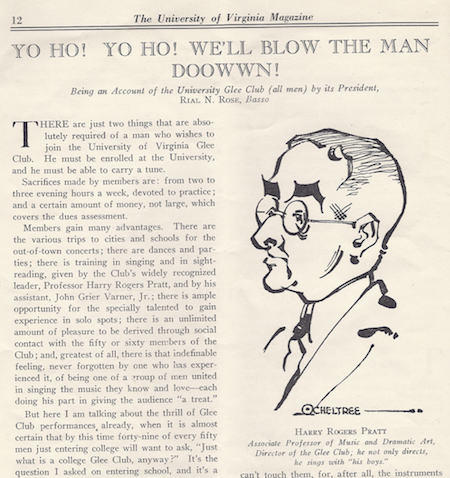
In the process of putting together the Virginia Glee Club Wiki, containing the history of that illustrious 171-year-old assemblage, I’ve made my way through just about every official archive of Glee Club history. But there are gaps to be filled, so I’ve resorted to eBay. I’ve picked up yearbooks, magazines, and other ephemera trying to find information on missing years. And in the process, I’ve gotten hooked on the convenience and the thrill of it all. I’ve also grown a little blasé about it, paradoxically enough–one too many speculative purchases of Virginiana has ended in a cold trail, historically speaking.
So I wasn’t expecting much when I won an auction for the September 1935 edition of the University of Virginia Magazine (winning bid: $1.50). To my surprise, though, I hit pay dirt. This was the “new student” issue of the magazine, and it featured essays from each of the leaders of the (non-fraternity) student groups introducing to prospective students such Virginia institutions as Corks & Curls, the UVA Band, the Jefferson Society …. and the Glee Club.
I’ve posted the top half of the article above, including a pretty fair pen-and-ink caricature of the Club’s raconteur director from the 1930s, Harry Rogers Pratt. The rest of the article and a transcription have been posted to the wiki on the biography page of its author, Glee Club president Rial Rose. The article is pretty modest about the group’s requirements and ambitions:
There are just two things that are absolutely required of a man who wishes to join the University of Virginia Glee Club. He must be enrolled at the University, and he must be able to carry a tune.
But Rose does a spectacular job of defining the college glee club of the 1930s and painting a picture of what’s involved:
Now, a College Glee Club, in these days, is a very ambitious organization. It attempts to combine the best of all these various kinds of music. The religious and folk music of the negroes and Cossacks appear on the same programs with the popular and “pretty” music of the “Pennsylvanians,” and with the strong, soul-stirring music of the great composers. In 1934-35, for instance, the University Glee Club sang music of America, England, Germany, Russia, Finland, the Netherlands, and the Latin Church, while a quartet sang negro songs, on a typically arranged program. And, not content with merely singing the music, we attempted to perform it nearly as possible in the various styles of the peoples it represented.
For me, this is what’s so fascinating about the history of this group. Save for one or two phrases, this could be a description of the Glee Club I sang in, or the one that is under the direction of Frank Albinder today. But then in the middle, there’s that reminder that the Glee Club, like the University, was a creature of its times: “negro songs.” At least this incarnation of the Glee Club wasn’t performing them in blackface.
